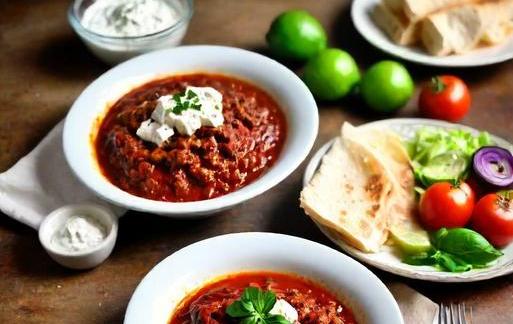- You are here:
- Home »
- Food
- » [REVEALED] Greek Foods That Start With G
[REVEALED] Greek Foods That Start With G
Note: This page contains affiliate links.
As an Amazon Associate, I earn from qualifying purchases when you click on the link, but you are not charged extra.
Greek cuisine is a tapestry woven with flavors, history, and tradition. From the sun-drenched islands to the rugged mountains, Greece boasts a rich culinary heritage that has influenced global gastronomy. In this exploration, we delve into the realm of Greek foods that start with the letter G, uncovering the nuances of taste, preparation methods, and cultural significance. From savory delights to sweet indulgences, each dish provides a glimpse into the vibrant tapestry of Greek culinary artistry.
Contents
List Of Greek Foods That Start With G

1. Gyros
Gyros, a ubiquitous street food, encapsulates the essence of Greek fast cuisine. Thin slices of seasoned meat, often lamb or chicken, are vertically stacked on a rotating spit. The succulent meat is then thinly sliced and typically served in a pita wrap. Accompanied by tomatoes, onions, and a dollop of tzatziki, gyros offer a burst of flavors and textures.
2. Greek Salad
A timeless classic, the Greek salad is a refreshing medley of crisp cucumbers, ripe tomatoes, briny Kalamata olives, and creamy feta cheese. Drizzled with extra virgin olive oil and sprinkled with dried oregano, this salad is a celebration of freshness and simplicity. It’s not just a dish; it’s a vivid mosaic of colors and tastes.
3. Galaktoboureko
Dessert aficionados rejoice at the mention of Galaktoboureko. This sweet treat is a custard-filled pastry, boasting layers of phyllo dough and a syrupy coating. The custard, made from semolina, eggs, and milk, is infused with a hint of lemon. The result is a decadent dessert that reflects the sweet side of Greek culinary expertise.
4. Gemista
A dish that mirrors the vibrancy of Greek summers, Gemista involves stuffing vegetables like tomatoes and bell peppers with a flavorful mixture of rice, herbs, and often ground meat. Baked to perfection and served with a side of tzatziki, Gemista showcases the bounty of the Greek countryside in a single, delightful dish.
5. Graviera
Graviera is a distinguished Greek cheese, often made from sheep’s milk. Aged to perfection, it boasts a firm texture and a complex, nutty flavor. Served in chunks or grated over various dishes, Graviera is a staple in Greek cuisine. Its versatility ranges from being a stand-alone snack to a key ingredient in savory pies and casseroles.
6. Garides Saganaki
For seafood enthusiasts, Garides Saganaki is a dish that tantalizes the taste buds. Plump shrimp are sautéed in a tomato-based sauce enriched with feta cheese. Often accented with garlic, herbs, and a splash of ouzo, this dish exemplifies the fusion of flavors that characterizes Greek coastal cuisine.
7. Gigantes Plaki
Gigantes Plaki is a hearty and nutritious dish featuring giant beans, often butter beans, baked in a rich tomato sauce. Seasoned with olive oil, herbs, and a hint of sweetness, this dish is a comforting staple in Greek households. The beans absorb the flavors of the sauce, creating a harmonious and satisfying meal.
8. Glyko Koutaliou
In the realm of preserves and sweets, Glyko Koutaliou stands out. These are fruit preserves, where fruits like quince or cherries are simmered in sugar syrup until they reach a delightful, spoonable consistency. Often enjoyed as a spoonful of sweetness alongside a cup of Greek coffee, these preserves are a testament to Greek hospitality and the art of preserving seasonal flavors.
9. Greek Coffee
An integral part of Greek culture, Greek coffee is a finely ground and unfiltered coffee, brewed to perfection in a special pot called a briki. Served in small cups, this strong and aromatic coffee is often accompanied by a glass of cold water. It’s not just a caffeine fix; it’s a social ritual embedded in the fabric of Greek daily life.
10. Galatopita
Dessert enthusiasts are in for another treat with Galatopita. This custard pie, akin to a creamy milk pie, is a symphony of milk, eggs, sugar, and phyllo pastry. Baked until golden brown and often topped with a dusting of cinnamon, Galatopita is a luscious conclusion to any Greek meal.
Greek cuisine, with its diverse array of flavors and textures, has a way of transporting us to the sun-kissed landscapes of the Mediterranean. From the savory delights of Gyros and Gemista to the sweet indulgences of Galaktoboureko and Galatopita, each dish reflects the deep-rooted connection between Greek culture, history, and food. As we traverse the culinary landscape of Greek foods that start with G, we discover not just ingredients and recipes, but a narrative of tradition, hospitality, and the joy of communal dining. Whether savoring the tangy notes of a Greek salad or indulging in the richness of Graviera, each bite tells a story—a story of a culture that cherishes the simple pleasures of life, shared around a table with loved ones. In the world of Greek gastronomy, the letter G is not just a letter; it's a gateway to a world of culinary wonders waiting to be explored, tasted, and appreciated. So, immerse yourself in the symphony of flavors, embark on a culinary journey through the Greek foods that start with G, and let each dish be a chapter in your own gastronomic odyssey. Opa!
Significance

Greek cuisine is renowned for its rich history, flavorful ingredients, and culinary traditions that have stood the test of time. From moussaka to tzatziki, the Greek culinary landscape is a treasure trove of delicious and diverse dishes. In this exploration, we delve into the realm of Greek foods that start with the letter ‘G’, uncovering the unique gastronomic delights that grace Greek tables.
Understanding the significance of Greek foods that start with ‘G’ requires a journey into the cultural and historical tapestry of Greece. Food in Greece is not merely sustenance; it is a reflection of the country’s heritage, geography, and agricultural abundance. Each dish carries a piece of the past, with recipes often handed down through generations, preserving the essence of Greek identity.
The letter ‘G’ in Greek cuisine introduces us to a selection of dishes that are not only delicious but also deeply rooted in tradition. These foods showcase the diversity of Greek gastronomy and the artistry of combining simple ingredients to create extraordinary flavors.
Category-Related

1. Gyros
Description: Gyros, a staple of Greek street food, is a savory delight that consists of seasoned meat, typically lamb or chicken, cooked on a vertical rotisserie. The meat is thinly sliced and often served in a pita wrap with tomatoes, onions, and a dollop of tzatziki sauce.
Ingredients:
- Thinly sliced seasoned meat (lamb, chicken, or a mix)
- Pita bread
- Tomatoes
- Onions
- Tzatziki sauce (yogurt, cucumber, garlic, and mint)
Preparation:
The meat is marinated with a blend of Greek spices and herbs before being slow-cooked on a vertical rotisserie. Once cooked, the thinly sliced meat is placed inside a warm pita, topped with fresh tomatoes, onions, and a generous helping of tzatziki sauce.
2. Gemista
Description: Gemista, translated as "stuffed," refers to a delectable dish where vegetables like tomatoes, bell peppers, or zucchinis are hollowed out and filled with a flavorful mixture of rice, herbs, and minced meat. These stuffed vegetables are then baked to perfection.
Ingredients:
- Tomatoes, bell peppers, or zucchinis
- Rice
- Minced meat (usually beef or pork)
- Onions
- Herbs (parsley, dill)
- Olive oil
- Tomato sauce
Preparation:
The vegetables are carefully hollowed out, and a stuffing mixture comprising rice, minced meat, onions, and herbs is prepared. The hollowed vegetables are filled with this mixture, arranged in a baking dish, and baked until the flavors meld into a harmonious blend.
3. Galaktoboureko
Description: Galaktoboureko is a delightful dessert that combines layers of crispy phyllo dough with a creamy custard filling. After baking, a sweet syrup is poured over the dessert, resulting in a golden and syrup-soaked delicacy.
Ingredients:
- Phyllo dough
- Milk
- Semolina
- Eggs
- Sugar
- Butter
- Lemon zest
- Syrup (sugar, water, lemon juice)
Preparation:
A custard mixture is prepared with milk, semolina, eggs, sugar, and lemon zest. Layers of phyllo dough are brushed with butter and alternated with the custard mixture. After baking, a syrup made from sugar, water, and lemon juice is poured over the dessert, infusing it with sweetness.
Common Themes
Greek foods that start with ‘G’ share common themes that underscore the essence of Greek culinary traditions. These themes reflect the Mediterranean diet, which is characterized by an abundance of fresh and seasonal ingredients, the use of olive oil as a primary fat source, and an emphasis on herbs and spices for flavor enhancement.
1. Olive Oil As A Culinary Foundation
In many Greek dishes, olive oil serves as the cornerstone of flavor. Whether drizzled over salads, used in dressings, or incorporated into cooking, the rich and fruity notes of extra virgin olive oil elevate the taste of Greek cuisine. The use of olive oil not only enhances the flavor profile but also contributes to the health benefits associated with the Mediterranean diet.
2. Mediterranean Diet Emphasis On Fresh Produce
Greek cuisine embodies the principles of the Mediterranean diet, emphasizing the consumption of fresh, seasonal, and locally sourced produce. Vegetables, fruits, legumes, and whole grains play a central role in creating vibrant and nourishing dishes. The emphasis on fresh ingredients not only contributes to the deliciousness of Greek foods but also aligns with the health-promoting aspects of the Mediterranean diet.
3. Herbs And Spices For Flavorful Complexity
Herbs and spices are integral to Greek cuisine, enhancing the complexity of flavors in various dishes. From oregano and thyme to mint and dill, the use of aromatic herbs adds depth and character to both savory and sweet creations. The judicious blending of these herbs and spices is a testament to the culinary expertise passed down through generations in Greek households.
Interesting Facts
Exploring Greek foods that start with ‘G’ unveils intriguing facts that shed light on the cultural and historical dimensions of these culinary delights.
1. Greece: The Birthplace Of Olive Oil
Greece has a long-standing association with olive oil, often referred to as "liquid gold." It is believed that olive cultivation and the extraction of olive oil originated in ancient Greece. The olive tree held immense cultural significance, symbolizing peace, prosperity, and fertility. Today, Greek olive oil continues to be celebrated for its exceptional quality and distinct flavor.
2. Gyro Origins And Evolution
The iconic gyro has a fascinating history. Although it is now synonymous with Greek cuisine, its origins can be traced to the Middle East, where a similar dish called "shawarma" was popular. Gyro, with its unique blend of Greek flavors, gained popularity in Greece and beyond, becoming a beloved street food item enjoyed worldwide.
3. Gemista: A Culinary Tradition With Ancient Roots
The art of stuffing vegetables, as seen in gemista, has ancient roots in Greek cuisine. Historical records indicate that the Greeks and Romans were adept at preparing stuffed vegetables, showcasing a culinary tradition that has endured through centuries. Gemista serves as a delicious testament to the longevity of this culinary practice.
Conclusion
In the realm of Greek foods that start with “G”, we discover a tapestry of flavors, textures, and traditions that define Greek cuisine. From the savory allure of gyros to the comforting embrace of gemista and the sweet indulgence of galaktoboureko, each dish tells a story of Greece’s culinary heritage. The significance of these foods goes beyond the plate, reflecting the cultural richness, historical depth, and enduring traditions of the Greek people.
As we savor the delights of Greek cuisine, we appreciate the common themes that unite these ‘G’ dishes—olive oil as a culinary foundation, a focus on fresh produce, and the artful use of herbs and spices. These common threads weave together a gastronomic experience that transcends mere sustenance, inviting us to partake in the essence of Greek culture through every flavorful bite.
In closing, the exploration of Greek foods that start with ‘G’ invites us to appreciate the culinary artistry and cultural significance embedded in each dish. As we celebrate the diversity of Greek gastronomy, we are reminded that the letter ‘G’ in Greek cuisine represents not just a letter of the alphabet but a gateway to a world of culinary wonders.


